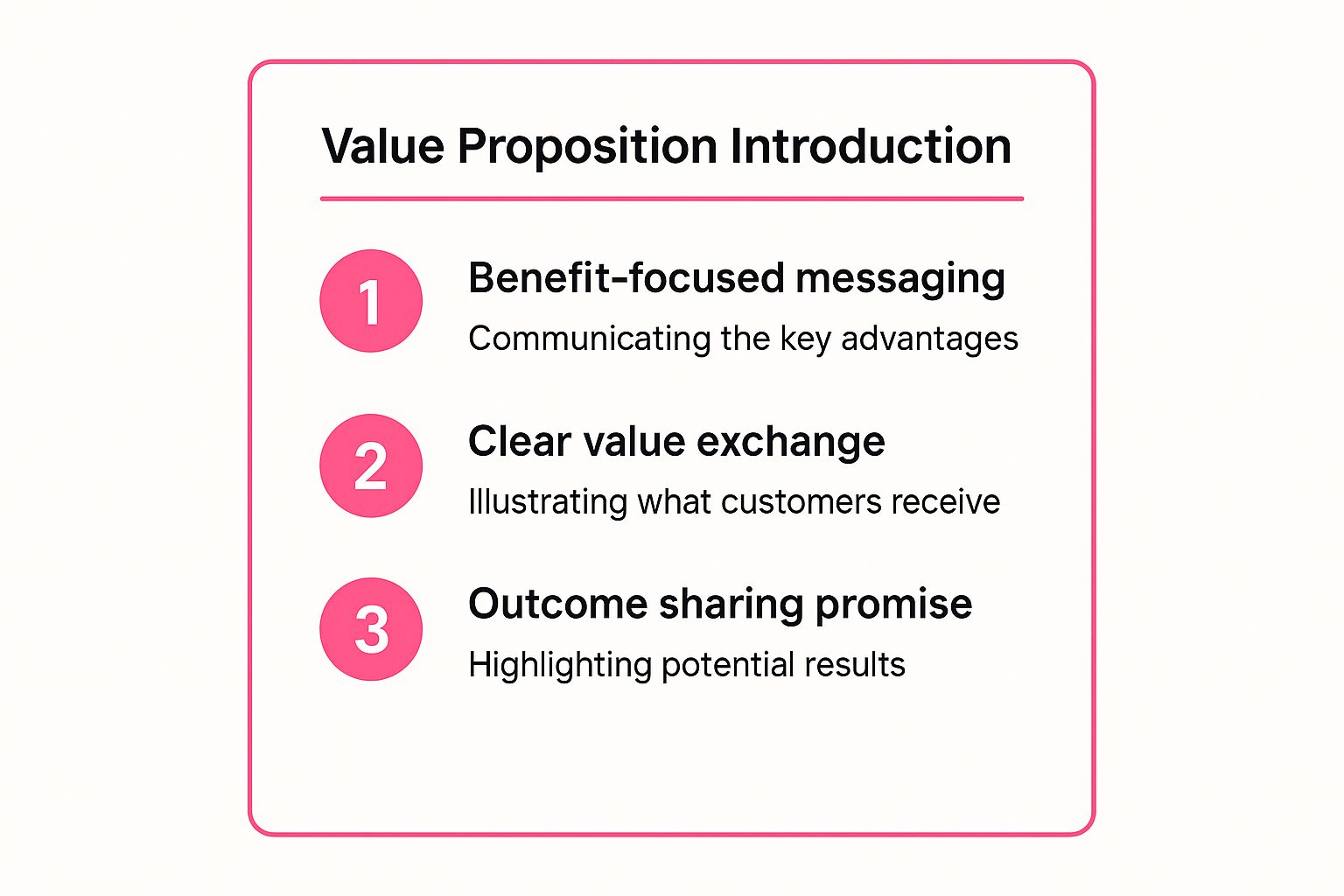Table of contents
The first few sentences of your survey can make or break your research. A compelling introduction grabs attention, builds trust, and convinces busy people to share their valuable time and insights. Get it wrong, and you are left with a high abandonment rate and skewed, unreliable data. A great opening is your best tool for ensuring high-quality responses from the right people, whether they are recent clients of your detailing business or customers of your digital agency.
This article explores the art and science behind crafting the perfect survey opening. We will move beyond generic templates to provide a strategic breakdown of different approaches. We will analyse seven distinct types of survey introduction examples, each tailored for specific goals and audiences from mortgage broking to accounting. You will learn not just what to write, but why it works, gaining replicable strategies to significantly boost your survey engagement.
For any business aiming to gather authentic customer feedback, mastering the introduction is the first, most crucial step. While tools can help automate the collection process, the initial human connection starts with the words you choose. This guide provides the practical, actionable examples you need to get that connection right every time and gather the data that truly matters.
1. The Value Proposition Introduction
The most effective way to grab someone's attention is to answer their unspoken question: “What’s in it for me?” The Value Proposition Introduction does exactly that. This approach immediately highlights the direct benefit the respondent will gain by participating, transforming the survey from a request into a mutually beneficial exchange.
This method frames your survey not as a favour you’re asking for, but as a collaborative effort where their input leads to a tangible outcome they care about. Whether it's improving a service they use daily, gaining access to exclusive industry insights, or contributing to meaningful research, the focus is always on the value delivered to the respondent. This is one of the most powerful survey introduction examples because it respects the respondent's time and provides a clear incentive from the very first sentence.
Strategic Breakdown
This introduction works by establishing a clear cause-and-effect relationship: your participation will lead to this specific, positive outcome. It’s a direct appeal to self-interest or a desire to contribute meaningfully.
- For a customer satisfaction survey: A digital agency might say, “Help us improve our project management portal. Your 5-minute feedback will directly influence the features we build next to save you time.”
- For market research: A buyer's agent could offer, “We're analysing the 2024 property market trends. Share your insights, and you’ll receive the full trends report before it's released to the public.”
When to Use This Approach
This strategy is highly effective when you have a clear, demonstrable benefit to offer and want to maximise your response rate from a specific, invested audience. It’s perfect for customer feedback, employee engagement, and market research within a professional community. It builds goodwill and shows that you value your audience's contribution, not just their data.
For a quick reference, this summary box highlights the core pillars of the value proposition method.

These three elements work together to create a compelling reason for someone to participate, moving beyond simple requests to create a genuine value exchange. By focusing your message on benefits and outcomes, you show respect for your audience's time and increase the likelihood of receiving thoughtful responses.
2. The Personal Story Introduction
Facts and figures can feel impersonal, but stories connect on a human level. The Personal Story Introduction leverages this by using a brief narrative to build an emotional bridge with respondents. This approach humanises the survey, explaining why the research matters by sharing a relatable anecdote, a customer experience, or the researcher's own motivation.

This method transforms the survey from a data collection exercise into a shared human experience. By revealing the "why" behind the questions, you invite respondents to become part of the solution to a real problem. For service-based professionals like mortgage brokers or accountants, this can be incredibly powerful for building client trust and showing you care about their journey. This is one of the more emotive survey introduction examples, as it taps into empathy and a shared sense of purpose.
Strategic Breakdown
This introduction works by establishing an emotional context that gives the respondent's feedback a sense of meaning and impact. The story provides a compelling reason to participate that goes beyond simple data collection.
- For a non-profit organisation: A charity might begin with, "Last winter, we met Sarah, a single mother struggling to keep her children warm. Her story inspired us to launch a new program, and your feedback will help us support more families like hers."
- For a digital agency: To get feedback on a new website build, the introduction could state, “Our client, a local cafe, told us customers found their old site confusing. We’ve just launched a new one, and your 3-minute review will help us ensure it's a success for them.”
When to Use This Approach
This strategy is most effective when your survey is tied to a mission with a clear human impact, such as improving healthcare services, supporting a social cause, or solving a genuine customer frustration. It is ideal for non-profits, healthcare researchers, and businesses that want to emphasise their client-centric values. This method fosters a deeper connection and encourages more thoughtful, considered responses because participants feel they are contributing to a meaningful narrative. Using storytelling is a cornerstone of authentic brand building; you can discover more about branding through storytelling on Testimonial Donut.
3. The Authority and Credibility Introduction
When a respondent isn’t familiar with your organisation, their default setting is often scepticism. The Authority and Credibility Introduction directly addresses this by establishing trust from the outset. This approach leverages your credentials, expertise, official partnerships, or notable endorsements to reassure participants about the survey's legitimacy and importance.
By highlighting what makes your organisation a credible source, you answer the unspoken question: “Why should I trust you with my time and information?” This method is particularly powerful because it replaces uncertainty with confidence. Mentioning affiliations with respected universities, government bodies, or industry associations provides a powerful signal that the research is serious, ethical, and valuable. This is one of the most essential survey introduction examples for projects where legitimacy is paramount.
Strategic Breakdown
This introduction works by borrowing trust from a recognised, authoritative source. The respondent transfers their positive perception of the established entity (e.g., a university, government agency, or professional body) to your survey. It’s a direct appeal to logic and a sense of security.
- For a research study: A buyer's agent surveying market sentiment could state, “This study is conducted in partnership with the Australian Property Institute to analyse the 2024 housing forecast. Your responses are anonymised and protected under university ethics guidelines.”
- For government data collection: A local council might introduce their survey by saying, “This is an official survey from the [Council Name] Planning Department, authorised under the Local Government Act 2020, to gather community feedback on the new town centre development.”
When to Use This Approach
This strategy is ideal when your survey is formal, deals with sensitive topics, or is sent to an audience that doesn't know you. It's the standard for academic research, government consultations, and large-scale industry reports from firms like Gallup or Pew Research. It helps to build credibility for your organisation by association, showing respondents that your work is held to a high standard.
For a quick reference, this summary box highlights the core pillars of the authority and credibility method.

These three elements combine to assure respondents that their participation is safe and meaningful. By leveraging external validation and transparently stating your affiliations, you remove a major barrier to participation and significantly increase the quality and quantity of your responses. To delve deeper into this, you can learn more about how to build credibility on testimonialdonut.com and apply those principles to your survey.
4. The Time-Conscious Introduction
In a world where everyone is busy, one of the biggest barriers to survey completion is the fear of it taking too long. The Time-Conscious Introduction directly confronts this by leading with transparency and respect for the respondent's schedule. It immediately tells them how short the survey is, reassuring them that their contribution will be quick and efficient.

This approach is built on the principle of managing expectations. By providing a clear time estimate upfront, you eliminate the uncertainty that causes many people to abandon a survey before it even starts. It signals that you value their time as much as their feedback, which can significantly reduce drop-off rates. This is one of the most practical survey introduction examples because it addresses a universal concern for any audience, from busy professionals to on-the-go customers.
Strategic Breakdown
This introduction works by removing a key psychological barrier: the perceived time commitment. It frames the survey as a small, manageable task rather than an open-ended obligation. Honesty and accuracy are crucial here; a misleadingly short time estimate will destroy trust.
- For an employee engagement survey: An accounting firm could state, “Have 3 minutes? We want to hear your thoughts on our new hybrid work policy. This quick pulse survey will help us make immediate adjustments.”
- For customer feedback: A car detailer might send a text message saying, “How did we do today? Let us know in this 2-minute mobile-friendly survey. Your feedback helps us maintain our 5-star service.”
When to Use This Approach
This strategy is essential for any survey where you anticipate your audience is time-poor, which, in today's market, is almost always. It is particularly effective for post-transaction feedback, quick pulse checks, and mobile-based surveys where convenience is paramount.
To ensure this method is successful, always test how long your survey takes for an average user and consider providing a slightly longer estimate to be safe. Highlighting that the survey is mobile-friendly also adds another layer of convenience, assuring respondents they can complete it whenever and wherever they have a spare moment.
5. The Exclusive Invitation Introduction
Making someone feel special is a powerful psychological trigger. The Exclusive Invitation Introduction leverages this by framing the survey not as a mass request, but as a unique opportunity extended only to a select group. This approach creates a sense of importance and privilege, tapping into the human desire to be part of an exclusive club.
By communicating that the respondent has been specifically chosen, you transform the act of participation from a chore into a status symbol. This method implies that their opinion is more valuable or informed than the average person's, which can significantly boost both response rates and the quality of feedback. This is one of the most effective survey introduction examples for engaging high-value audiences because it appeals to their sense of expertise and importance.
Strategic Breakdown
This introduction works by creating scarcity and prestige. It suggests that not everyone gets this opportunity, making the invitation feel more valuable. It’s a direct appeal to the respondent's ego and sense of belonging to a distinguished group.
- For a VIP customer experience survey: A luxury car detailer might say, “As one of our most valued clients, you’ve been selected to provide feedback on our new premium ceramic coating service. Your expert opinion is crucial before we offer it to the public.”
- For an expert opinion survey: An accounting firm could state, “You are one of only 50 industry leaders we’re inviting to share insights on the upcoming changes to tax law. Your participation will help shape our 2025 financial strategy guides.”
When to Use This Approach
This strategy is ideal when you are targeting a niche, high-value segment whose feedback is genuinely more impactful than a general audience’s. It’s perfect for beta testing with power users, gathering insights from industry leaders, or collecting feedback from a VIP customer tier. To be authentic, you must have a legitimate reason for selecting the respondent, as this builds trust and reinforces their perceived importance.
This summary box highlights the core pillars of the exclusive invitation method.
These three elements combine to create a compelling invitation that makes respondents feel valued and essential. By carefully framing your survey as an exclusive opportunity, you increase the likelihood of receiving thoughtful, detailed responses from the people whose opinions matter most to your business.
6. The Problem-Solution Introduction
Another highly effective approach is to frame your survey around a shared challenge. The Problem-Solution Introduction identifies a specific pain point or obstacle relevant to your audience and positions the survey as a crucial step toward finding a solution. This method creates immediate relevance and a sense of shared purpose, motivating participation by tapping into a desire for improvement and resolution.
This introduction works by saying, “We recognise this problem, and we believe you do too. Let’s work together to fix it.” It transforms the survey from a data collection tool into a collaborative problem-solving exercise. By focusing on a challenge that resonates with respondents, such as workplace inefficiencies or community issues, you create a sense of urgency and importance. This is one of the more compelling survey introduction examples because it appeals to a collective desire to overcome obstacles and improve a shared situation.
Strategic Breakdown
This introduction builds a narrative where the respondent is a key player in overcoming a common adversary: the problem itself. It establishes a clear, compelling reason to participate by linking their feedback directly to a tangible resolution.
- For an employee engagement survey: An accounting firm could state, “We know end-of-quarter reporting creates significant burnout. This 10-minute survey will help us identify key stressors and reorganise workflows to better support your well-being.”
- For a community-focused survey: A buyer’s agent might say, “Many first-home buyers are struggling with local council planning delays. Your feedback will inform our submission to the council to help streamline the approval process for everyone.”
When to Use This Approach
This strategy is ideal when you are addressing a known and significant pain point within a specific group, like employees, customers, or community members. It is particularly powerful for driving change and demonstrating that your organisation is listening and proactive. Use it to tackle issues like employee burnout, customer service friction, or systemic process inefficiencies. It shows empathy and positions your organisation as a solution-oriented partner.
By framing the issue constructively and connecting it to actionable outcomes, you can balance the sense of urgency with optimism. This approach not only gathers valuable data but also strengthens relationships by showing you are committed to solving the problems that matter most to your audience. For a deeper dive into this technique, you can explore additional resources on crafting a Problem-Solution Introduction. Learn more about the Problem-Solution Introduction on testimonialdonut.com.
7. The Transparent and Honest Introduction
In an era of data privacy concerns, the most direct path to earning a respondent's trust is through radical transparency. The Transparent and Honest Introduction prioritises clear, upfront communication about your survey’s purpose, how the data will be used, and how the respondent's privacy will be protected. It builds credibility not with incentives, but with integrity.
This method appeals to a respondent’s sense of security and their right to informed consent. Instead of trying to persuade, you simply present the facts: why you are asking, what you will do with the information, and who to contact with questions. This approach is one of the most vital survey introduction examples for any organisation handling sensitive information, as it demonstrates respect for the individual and their data from the outset.
Strategic Breakdown
This introduction works by removing all ambiguity and potential suspicion. It preemptively answers the critical questions a cautious participant might have, such as "Where is my data going?" and "How will this be used?" This builds a foundation of trust that can lead to more thoughtful and accurate responses.
- For a government or council survey: An agency might state, “This survey is conducted under the Privacy Act 1988. Your anonymous responses will inform the allocation of community infrastructure funds for the 2025 financial year. All data is aggregated and individual responses will never be shared.”
- For academic research: A university researcher could explain, “This study on remote work trends is part of a PhD thesis. All data is confidential, stored on a secure university server, and will be anonymised for publication. Participation is voluntary, and you can withdraw at any time.”
When to Use This Approach
This strategy is non-negotiable when dealing with sensitive personal information, such as in medical research, financial surveys, or government data collection. It is also highly effective for any organisation that wants to build long-term trust with its audience, particularly professional service providers like accountants or mortgage brokers who handle confidential client details.
Use this method when your primary goal is to assure participants of their security and the ethical handling of their data. It proves that you are a trustworthy custodian of information, which is often more valuable than any small incentive you could offer. By being forthright and honest, you not only improve the quality of your responses but also enhance your brand’s reputation for integrity.
Survey Introduction Styles: 7 Key Comparisons
Crafting Your Perfect Survey Introduction
Throughout this article, we’ve explored a diverse toolkit of survey introduction examples, moving far beyond a one-size-fits-all approach. From establishing credibility with the Authority Introduction to creating urgency with the Exclusive Invitation, each strategy serves a distinct purpose. The key lesson is that the most effective introductions are never an afterthought; they are a deliberate strategic choice.
By analysing these examples, we've uncovered the core principles that drive high response rates. It’s not just about what you say, but how you frame your request. A successful introduction is an exercise in empathy, anticipation, and clear communication. It anticipates the respondent's potential questions, respects their time, and provides a compelling reason for them to engage.
Synthesising Your Strategy
The true power of these techniques emerges when you begin to combine them. Think of the examples we've detailed not as rigid templates but as modular components you can assemble to create the perfect invitation for your specific audience.
- Combine for Impact: A Time-Conscious introduction becomes significantly more persuasive when paired with a strong Value Proposition. For instance, a mortgage broker could say, "Got 2 minutes? Your feedback will help us simplify the home loan process for others, and we’ll send you our exclusive guide to navigating interest rate changes as a thank you."
- Align with Your Goal: If your goal is to gather detailed, thoughtful feedback for service improvement, a Problem-Solution intro combined with a Personal Story can be incredibly effective. It frames participation not as a task, but as a collaborative effort to solve a shared challenge.
- Optimise the First Touchpoint: The principles of a strong survey introduction, like clarity and a clear value exchange, are directly applicable to other initial points of contact. For insights into designing other forms that encourage completion, consider the strategies found in leading high-converting contact form examples.
From Theory to Actionable Results
Ultimately, mastering survey introductions is about transforming a simple request into a compelling invitation. It’s the difference between asking for a favour and offering an opportunity. When you respect your audience’s time and intelligence, they are far more likely to provide the thoughtful, high-quality data your business needs to thrive.
Before you send your next survey, pause and review these strategies. Ask yourself: Who am I speaking to? What is their likely hesitation? And what is the most compelling reason they should participate? Answering these questions will empower you to move beyond generic requests and craft introductions that not only get opened but get completed. This deliberate approach turns feedback collection from a routine task into a powerful engine for building customer relationships and driving meaningful business growth.
Ready to turn these principles into practice? Testimonial Donut helps you automate sending perfectly crafted survey requests and organises the valuable feedback you receive. Start collecting powerful testimonials and insights today by creating a system that works for you.



